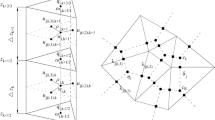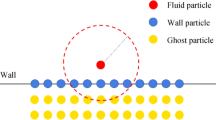Abstract
Fluid–structure interactions are modelled by coupling the finite element fluid/ocean model ‘Fluidity-ICOM’ with a combined finite–discrete element solid model ‘Y3D’. Because separate meshes are used for the fluids and solids, the present method is flexible in terms of discretisation schemes used for each material. Also, it can tackle multiple solids impacting on one another, without having ill-posed problems in the resolution of the fluid’s equations. Importantly, the proposed approach ensures that Newton’s third law is satisfied at the discrete level. This is done by first computing the action–reaction force on a supermesh, i.e. a function superspace of the fluid and solid meshes, and then projecting it to both meshes to use it as a source term in the fluid and solid equations. This paper demonstrates the properties of spatial conservation and accuracy of the method for a sphere immersed in a fluid, with prescribed fluid and solid velocities. While spatial conservation is shown to be independent of the mesh resolutions, accuracy requires fine resolutions in both fluid and solid meshes. It is further highlighted that unstructured meshes adapted to the solid concentration field reduce the numerical errors, in comparison with uniformly structured meshes with the same number of elements. The method is verified on flow past a falling sphere. Its potential for ocean applications is further shown through the simulation of vortex-induced vibrations of two cylinders and the flow past two flexible fibres.










Similar content being viewed by others
References
Backhaus JO, Verduin JJ (2008) Simulating the interaction of seagrasses with their ambient flow. Estuar Coast Shelf Sci 80:563–572
Basset AB (1961) A treatise on hydrodynamics with numerous examples. Dover, New York
Brown PP, Lawler DF (2003) Sphere drag and settling velocity revisited. J Environ Eng 129(3):222–231
Borazjani I, Sotiropoulos F (2009) Vortex-induced vibrations of two cylinders in tandem arrangement in the proximity-wake interference region. J Fluid Mech 621:321–364
Clift R (1978) Bubbles, drops, and particles. Academic, New York
Dean RG, Dalrymple RA (1991) Water wave mechanics for engineers and scientists. World Scientific, Singapore
Farhat C, Lesoinne M, LeTallec P (1998) Load and motion transfer algorithm for fluid/structure interaction problems with non-matching discrete interfaces: momentum and energy conservation, optimal discretization and application to aeroelasticity. Comput Methods Appl Mech Eng 157:95–114
Farrell PE (2009) Galerkin projection of discrete fields via supermesh construction. Ph.D. thesis, Imperial College London
Farrell PE (2011) The addition of fields on different meshes. J Comput Phys 230(9):3265–3269
Farrell PE, Maddison JR (2011) Conservative interpolation between volume meshes by local galerkin projection. Comput Methods Appl Mech Eng 200:89–100
Farrell PE, Piggott MD, Pain CC, Gorman GJ, Wilson CR (2009) Conservative interpolation between unstructured meshes via supermesh construction. Comput Methods Appl Mech Eng 198:2632–2642
Glowinski R, Pan TW, Periaux J (1994) A fictitious domain method for external incompressible viscous flow modeled by Navier–Stokes equations. Comput Methods Appl Mech Eng 112:133–148
Glowinski R, Pan T-W, Hesla TI, Joseph DD (1999) A distributed Lagrange multiplier/fictitious domain method for particulate flows. Int J Multiph Flow 25(5):755–794
Gresho PM, Sani RL (1998) Incompressible flow and the finite element method. Wiley, London
Griffith BE, Hornung RD, McQueen DM, Peskin CS (2007) An adaptive, formally second order accurate version of the immersed boundary method. J Comput Phys 223:10–49
Jaiman RK, Jiao X, Geubelle PH, Loth E (2006) Conservative load transfer along curved fluid–solid interface with non-matching meshes. J Comput Phys 218:372–397
Jiao X, Heath MT (2004) Overlaying surface meshes. Part I: algorithms. Int J Comput Geom Appl 14(6):379–402
Latham J-P, Mindel J, Xiang J, Guises R, Garcia X, Pain CC, Gorman GJ, Piggott MD, Munjiza A (2009) Coupled FEMDEM/Fluids for coastal engineers with special reference to armour stability and breakage. Geomechanics and Geoengineering 4(1):39–53
Luhar M, Coutu S, Infantes E, Fox S, Nepf H (2010) Wave-induced velocities inside a model seagrass bed. J Geophys Res 115(C12005):1–15
Maman N, Farhat C (1995) Matching fluid and structure meshes for aeroelastic computations. A parallel approach. Comput Struct 54(4):779–785
Mark A, van Wachem BGM (2008) Derivation and validation of a novel implicit second-order accurate immersed boundary method. J Comput Phys 227:6660–6680
Mei R (1994) Flow due to an oscillating sphere and an expression for unsteady drag on the sphere at finite Reynolds number. J Fluid Mech 270:133–174
Mittal R, Iaccarino G (2005) Immersed boundary methods. Annu Rev Fluid Mech 37:239–261
Munjiza A (2004) The combined finite-discrete element method. Wiley, New York
Nino Y, Garcia M (1994) Gravel saltation: 2. Modeling. Water Resour Res 30(6):1915–1924
Pain CC, Umpleby AP, de Oliveira CRE, Goddard AJH (2001) Tetrahedral mesh optimisation and adaptivity for steady-state and transient finite element calculations. Comput Methods Appl Mech Eng 190:3771–3796
Pain CC, Piggott MD, Goddard AJH, Fang F, Gorman GJ, Marshall DP, Eaton MD, Power PW, de Oliveira CRE (2005) Three-dimensional unstructured mesh ocean modelling. Ocean Model 10:5–33
Peskin CS (1972) Flow patterns around heart valves: a numerical method. J Comput Phys 10:252–271
Piggott MD, Gorman GJ, Pain CC, Allison PA, Candy AS, Martin BT, Wells MR (2008) A new computational framework for multi–scale ocean modelling based on adapting unstructured meshes. Int J Numer Methods Fluids 56:1003–1015
Piggott MD, Farrell PE, Wilson CR, Gorman GJ, Pain CC (2009) Anisotropic mesh adaptivity for multi-scale ocean modelling. Philos Trans R Soc A 367:4591–4611
van Loon R, Anderson PD, van de Vosse FN, Sherwin SJ (2007) Comparison of various fluid-structure interaction methods for deformable bodies. Comput Struct 85:833–843
Xiang J, Munjiza A, Latham J-P (2009) Finite strain, finite rotation quadratic tetrahedral element for the combined finite–discrete element method. Int J Numer Methods Eng 79:946–978
Xiang J, Latham J-P, Zimmer D, Baird B, Fons M (2011) Modelling breakwater armour layers and the dynamic modelling breakwater armour layers and the dynamic response of armour units In: Proceedings of the coastal structures 2011 conference held in Yokohama, Japan
Zienkiewicz OC, Taylor RL (2000) The finite element method 5th edn. Butterworth–Heinemann, Oxford
Acknowledgements
The authors wish to acknowledge support from EPSRC (under projects EP/I00405X/1 and EP/H030123/1) and NERC (under grant NE/F012594/1), as well as the Grantham Institute for Climate Change and the High Performance Computing Service at Imperial College London. A.V. is supported by the European Union Seventh Framework Programme (FP7/2007-2013) under grant agreement PIEF-GA-2010-272437, and she is also grateful to the Belgian Vocatio Foundation. P.E.F.’s work was supported by a Center of Excellence grant from the Norwegian Research Council to the Center for Biomedical Computing at Simula Research Laboratory. The content of this paper reflects only the authors views and not those of the European Commission.
Author information
Authors and Affiliations
Corresponding author
Additional information
Responsible Editor: Sergey Danilov
This article is part of the Topical Collection on Multi-scale modelling of coastal, shelf and global ocean dynamics
Rights and permissions
About this article
Cite this article
Viré, A., Xiang, J., Milthaler, F. et al. Modelling of fluid–solid interactions using an adaptive mesh fluid model coupled with a combined finite–discrete element model. Ocean Dynamics 62, 1487–1501 (2012). https://doi.org/10.1007/s10236-012-0575-z
Received:
Accepted:
Published:
Issue Date:
DOI: https://doi.org/10.1007/s10236-012-0575-z




